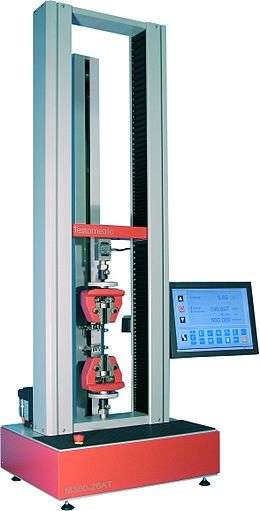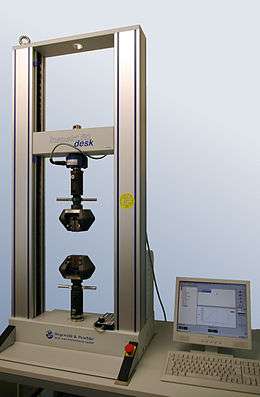Trekbank
Een trekbank of drukbank wordt gebruikt om materialen, metalen, kunststoffen of producten, te testen. Een voorbeeld is het aan beide zijden inklemmen van een strip metaal, die daarna uit elkaar wordt getrokken. Dit wordt een trekproef genoemd.

Trekbank

Spanning-rekdiagram van zacht staal

Trekbank tot 50 kN bij Hegewald & Peschke
Meestal worden twee gegevens gemeten:
- de lengte: door het uit elkaar trekken wordt de strip metaal langer;
- de kracht die gebruikt wordt voor het uit elkaar trekken: deze neemt toe totdat het stuk metaal begint te vloeien of breekt. Bij moderne trekbanken vindt de registratie van kracht en verplaatsing plaats via een computer met software. De software voert daarbij alle gewenste berekeningen uit.
Uit de kracht en de afmeting (doorsnede) van de teststrip kan de uitgevoerde spanning worden berekend.
Het resultaat van een test is een spanning-rekdiagram (ook wel 'trek-rekkromme' of 'trekcurve'). Dit is een diagram, waarin de spanning σ als gevolg van een trekkracht op een materiaal wordt uitgezet tegen de relatieve rek ε (verlenging als percentage van de oorspronkelijke lengte).
Normen
De normen voor een trekbank zijn als volgt gedefinieerd:
- EN ISO 6892-1: Metallic materials - Tensile testing - Part 1: Method of test at room temperature (replaces EN 10002)
- EN ISO 7500-1/-2 Metallic materials - Verification of static uniaxial testing machines - Part 1: Tension/compression testing machines - Verification and calibration of the force-measuring system; Part 2: Tension creep testing machines - Verification of the applied force
- DIN 51220 Materials testing machines - Generals for requirements and for verification and calibration of materials testing machines
- ASTM E4 - Practices for Force Verification of Testing Machines
- ASTM E74 - Practice for Calibration of Force Measuring Instruments for Verifying the Force Indication of Testing Machines
- ASTM E83 - Practice for Verification and Classification on Extensometer Systems
- ASTM E1012 - Practice for Verification of Test Frame and Specimen Alignment Under Tensile and Compressive Axial Force Application
- ASTM E1856 - Standard Guide for Evaluating Computerized Data Acquisition Systems Used to Acquire Data from Universal Testing Machines
- JIS K7171 - Standard for determine the flextural strength for plastic material & products
- ISO 5893 Rubber and plastics test equipment - Tensile, flexural and compression types (constant rate of traverse) - Specification
This article is issued from
Wikipedia.
The text is licensed under Creative
Commons - Attribution - Sharealike.
Additional terms may apply for the media files.